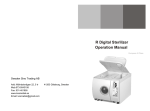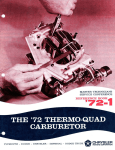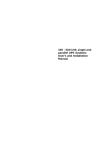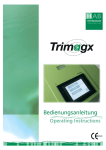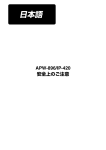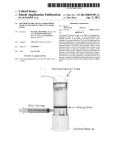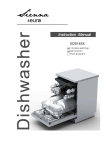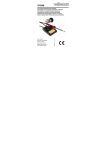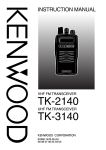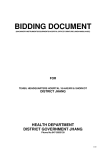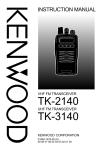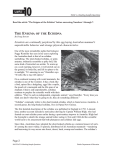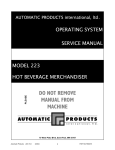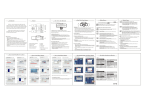Download EPM MUELLER® Modular Extractor System 2 - epm
Transcript
Extraction ction Tools for Total Hip ip Replacem Replacements EPM Mueller ueller® Stem Extractor AU/AU2 /AU2, S/S2, EPM Mueller® Modular Extractor tractor Syste System 2 „Kno „Knockout Tool for Joint Prosthesis“ CE, ISO 13485 FDA DA Establishment Establish Registration Number: 3003759646 Patented in most ost countrie countries, USA Pat.Nr.5.534.006, USA Pat.Nr. at.Nr. 8.603 8.603.100B2, EP 0.645.127, DE 43.32.872 C1 Technic Documentation Technical Development of EPM Endo Plant Müller GmbH Developm Copyrig ©1993-2014 . All rights reserved Copyright EPM Endo o Plant Mülle Müller GmbH · Schleusen Str. 8, 63839 39 Kleinwall Kleinwallstadt Tel.:+49 +49-(0)6022/25419 · Fax: +49-(0)6022/25419 e-Mail: [email protected] Ust - IdNr.:180825097, IdNr.:18082 Registered Aschaffenburg, g, HRB 8276 man manager: E.J.Müller MD.MDstom. www www.epm-mueller.de 1 Technical Documentation Content: 1. Introduction 2. Definition of medical tasks 3. Finite-element model (FEM) analysis for revision with conventional extractors 3.1. Finite element (FEM), conditions and loads 3.2. Results and discussion 4. Principle and construction of the EPM Mueller® Stem Extractor 5. Measurement of the functional Prototype 6. The EPM Mueller® Extractor, the EPM Mueller® Modular Extractor System 2 6.1. EPM Mueller® Stem Extractor 6.2. EPM Mueller® Modular Extractor System 2 6.2.1. EPM Mueller® Modular Extractor system 2 components 6.2.2. EPM Mueller® Modular Extractor System 2 posibilities 7. FEM analysis for the revision of the EPM Mueller® Stem Extractor 8. Clinic use in Garmisch-Partenkirchen KKH with the EPM Mueller® Stem Extractor 9. User manual 9.1. EPM Mueller® hip stem Extractor 9.1.1. short description 9.1.2. components 9.1.3. handling 9.1.4. detachment 9.2. EPM Mueller® Modular hip stem Extractor MO1 9.1.2. components 9.1.3. handling 9.1.4. ddetachment 9.3. EPM Mueller® Knee prosthesis Extractor KN2 9.3.1. components 9.3.2. handling 9.3.3. ddetachment 9.4. EPM Mueller® Acetabular hemispherical- and Screw-cup Extractor C2 9.4.1. components 9.4.2. handling 9.4.3. ddetachment 9.5. EPM Mueller® Pin and sling Extractor PS2 9.5.1. components 9.5.2. handling 9.5.3. ddetachment 9.6. EPM Mueller® M6 hip stem Extractor M6 9.6.1. components 9.6.2. handling 9.6.3. ddetachment 9.7. EPM Mueller® Thread maker Set ™ 9.7.2. components 9.7.3. handling 9.8. EPM Mueller® hook Extractor H 9.8.1. components 9.8.2. handling 9.8.3. detachment 9.9. EPM Mueller® Quick adapter with curettes, osteotomes planing and pans 9.9.1. components 9.9.2. handling 9.9.3. detachment 9.10. maintenance 10. Cleaning and sterilization 10.1. Preparation 10.2. Recommended course of action for returned goods / returns 10.3. Preparation for cleaning and disinfection 10.4. Manual and machine cleaning and disinfection 10.5. Checks and Care 10.6. sterilization 10.7. Storage of non-sterile and sterile instruments 11. Technical data 12. Spare parts 13. Warranty, Service 2 1. Introduction Since its inception in the early 60’s, total hip replacement surgery has become enormously important; today it is one of the most successful surgical interventions in orthopedics. One of the problems in total hip replacement and joint replacement surgery in general, is the limited survival time of the implants which have not reached the biomechanical qualities of the natural hip joint. Today a survival time of 10 to 15 years is considered normal if no complications occur. After years of implantation time the devices loosen aseptically. This loosening is induced by wear particles. A loose prosthesis causes pain, which makes a revision operation necessary. (Fig. 1) One of the problems during Revision Operations is the removal of the femoral component from the femora. Even if the implant is loose and micro motion is possible, they are still fixed by soft tissue and therefore hard to remove. Fig. 1 Fig. 2 2. Definition of Medical and Technical Purposes 2.1. High, accurately directed forces have to be applied to the femoral component for short periods of time so that the extraction impulse only acts upon the femoral component itself. (Fig. 7) 2.2. The energy of the extraction impulse has to be so high that the connection between implant and femora (i.e. cement femora) is terminated before the energy of the impulse is transferred to the femora. (Fig. 5) 2.3. To achieve this, uniaxial force transfer is necessary as well as an extremely high connection force between instrument and femoral component. (Fig. 4) 2.4. The force vector has to be as close to the longitudinal axis of the femoral component as possible. (Fig. 4) 3. FEM-Analysis of Revision with Conventional Extraction Tools To visualize the special relationships and magnitudes of force potentials, and to compare the loads acting upon the cortical bone of the femora in revisions of the femoral component, a finite element strain analysis of the femora while extracting a femoral component with different extraction devices was performed. 3.1. Finite-Element-Modeling (FEM), Conditions and Loads: For the Finite-Element-Analysis (FEA), two identical femora with two identical femoral components were modeled. (Fig. 3,7). The femora were comprised of 3-D elements. The femoral component outside of the bone and heads of the extraction instruments were compiled of 2-D elements. For the calculations, the near-half symmetry of femora and femoral components were used. At the ends of the heads of the extraction instruments a ramp force profile of F=0 N at time t=0s to F=10 kN at t=30 ms was imprinted in axial direction. The axial direction is parallel to the middle axis of the femora in the FEM. Therefore this represents a best case for the conventional extraction instruments. (Fig. 3) The femora is imbedded in 2-D elements, which represent the properties of the muscle surrounding the bone. A strain-free condition is assumed at t=0. Fig. 3 3 Fig. 3 3.2. Results and Discussion iscussion To depict the strains inside the femurs and femoral components, ts, the von von-Mises-strains (s EQV) were used. The e FEA was performed in a transient mode. The diagram diagrams 3 and 7 show the von-Mises-strainss at maximal extraction forces at t=30 ms. One can notice the non-homoge homogenous distribution of strains inside ide the fem femoral component when conventional extraction to tools are used. (Fig. 3). One can an deduct an a asymmetrical transfer of forces to the he femora from fr this, which can only lead to a partial disconnection disc of the implant from the surrounding ounding tiss tissue. Therefore, multiple applications ons of the forces fo have to be performed. bution of th the strains in the cortical bone, extraction w with conventional Looking at the distribution tools causes high strains rains on the whole (Fig. 3, ABC) and especially ially high maximal ma strains in the middle of the prosthesis sthesis and a at the lower end of the prosthesis. s. (Fig. 3, D) With the conventionall extraction tools, the force vector is not directed ected along the longitudinal axis of the femoral component omponent - in the optimal case it is only parallel rallel to this axis (Xp) - the femoral component therefore jam jams and is hard to remove. The energy impu mpulse is conveyed laterally to the femora. Fractures of the trochantor chantor or the th shaft of the femora can occur. cur. (ABC). A misalignment between extraction vector ector and th the longitudinal axis of the prosthesis esis can lead to injury of the bone surrounding the prosthe prosthesis, to fractures and associated lengthening gthening of tthe surgical time and anesthesia, increasing asing of the risk of infection, etc. 4. Principle and Construction onstruction of the EPM Mueller® Extractor. Provide Axial force transfe transfer and maximal clamping force. Ensure the necessary cessary cla clamping force is transferred to the neck of the prosthesis via a curved toolhead. ad. (Fig. 4). The size of the e toolhead is minimized because of limited space pace during surgery. The instrument is handled ndled outside of the surgical field. (CAD AD picture) F Fig. 4 5. Measurements of Function Functional Prototype The prototype was measured easured wit with a special trial set-up and a Piezo-force force sensor. sen The profile of force application was register registered to monitor change of force over time and an calculate the transferred impulse. 4 A force was applied by hand via a weight against an infinitely hard ard base and an registered by the Piezo-sensor. Data ta were acq acquired by an oscilloscope and stored. The prototype of the extraction instrument is fixed and the weight (800g) g) is accelerated to about 10m/s. During the whole time e of the exp experiment, the oscilloscope storess the strain d delivered by the Piezo-sensor (strain proportional to force). The impulse transfer time t is calc calculated from the strain-time-diagram. (Fig. 5). K r a ft s t o ß v e r h a lte n - „ F u m u “ Sp an n u n g in V 1 0 -1 -2 -3 -4 -5 0 ,0 0 8 0 ,0 1 0 0 ,0 1 2 0 ,0 1 4 Z eit i n s Fig. 5 Results: From the graph of force rce transfer time t of t=500µs can be derived. A peak force of 50kN can be calc calculated for force transfer. This peak force corresponds sponds to a set-up with an infinitely hard base. se. In practi practical use an elastic fixation exists and conseq consequently the measurements stated above will not n be attained. Duration of the force:: 0,5ms (=0,0 (=0,0005s) Amount of force: 50Ns The impulse is high enough nough to ov overcome the holding forces inside of the bone and loosen the prosthesis. The clamping mechanism nism reliably transfers the force to the implant. Calculated clamping force at the neck of the prosthesis is 30kN. 6. The EPM Mueller® Stem Extractor E EPM Mueller® Extractor AU -with open head on the side and one ne sliding sp spacer, proper also for stems with fixed xed heads (monobloks) ( Fig. 6a with closed head and single sliding spacer EPM Mueller Extractor S -with ® Fig. 6b EPM Mueller Extractor AU-S S with 2 exchangeable heads (open AU+ + closed close S) and one sliding spacer ® Fig. 6c 6 2, geschlossene Spannrahmen und drei Druckba Druckbacken (A, B, C) EPM Mueller® Extractor AE2 EPM Mueller® Extractor PN-AU AU, PN-S, with adapter for pneumatic Fig. 6d 5 A revisions, with closed sed head, ssingle slider EPM Mueller® Extractor SA for Antero-access spacer and slider bar. Fig.6e ch by axial force transfer and exceptional excep clamping The EPM Mueller® Extractor is characterized mechanism. The necessary clamping ing force is transferred to the implant neck byy a curved ttoolhead. The size of the tool head ead is adapt adapted to space restrictions dictated by the surgical surgi procedure. The EPM Mueller® Extractor is handled ha outside of the surgical field. The EPM Mueller® Extractor xtractor AW AW6 has been in clinical use since 1993, the EPM Mueller® Extractor AE ( ABC Extractor ), the EPM Mueller® Extractor AU since 1999 and the EPM Mueller® Extractor S since 2004, 2004 the EPM Mueller® Extractor PN since ince 2007, 200 the EPM ® Mueller Modular Extractor xtractor System Sys 1 since 2009. ® We launch 2014 the new EPM Mueller M Extractor AS for Anteriorr approach rrevisions and the EPM Mueller® Modular odular Extra Extractor System 2. The EPM Mueller® Extractor can be fixed to the exposed neck of the prosthes prosthesis with a few easy movements and the prosthe prosthesis can be removed with limited time and force for requirements. The EPM Mueller Extractor tractor can b be removed from the prosthesis after fter extractio extraction via an easy snap-lock mechanism without a additional tools. It can be disassembled bled and as assembled easily and fits into a standard rd surgical tr tray. Easy cleaning and sterilization erilization ar are assured; the instrument is fully autoclavab autoclavable. 6.2.1. EPM Mueller® Modular Extractor System 2 components: - Hip Stem Extractor AU-S2) - Pneumatic Shaft Extractor - Extractor approach jaws for modular mod stems MO1 - Knee stem Extractor approach KN2 - Pan Extractor approach C2 - Pin and Loop Extractor approach approac PS2 - Screw Extractor approach M6 threaded makers Set ™ - Ruined screw remover set SR - Quick adapter with curettes,, planing and pan osteotomes - Chipping Extractor approach H2 - Sterilization basket with silicone lid supports and instruments We developed 2014 EPM Muelle Mueller® Modular Extractor System 2 based ased on the EPM Mueller® hip stem Extractor. Newly ewly developed develo attachments allows the extraction action of various var prostheses such as modular neckless kless hip, lar large head, knee, acetabular hemispherical ispherical or screw cups, pins, stuck drills and ruined screw screw. Together with the EPM M Mueller® stem Extractor AU-S2 the Modular ular Extracto Extractor system2 attachments provide a complete solution for prosthesis revision problems.. 6.2.2. EPM Mueller® Modular Extractor Ex System 2 -use possibilities: - EPM Mueller® stem Extractor S2, or AU2 - EPM Mueller® Pneumatik umatik Sha Shaft PN2 ( for Woodpacker ) 6 - EPM Mueller® Modular stem Extractor MO1 - EPM Mueller® Knee shaft Extractor Extr KN2 with extra spreading jaws, with option of chisels with quick adapter Option: The knee shaft extractor jaws can also be used for tibial component, large head hip stems, shoulder stems, modular ular stocked heads and stocked drills. - EPM Mueller® hemispherical erical and Screw cup Extractor C2 with extra spreading eading jaws and housing handle, with option of cup osteotome osteoto and quick adapter and hook attachment option 7 - EPM Mueller® stem Extractor M6 attachment Suitable for the extraction of stems stem with M6 threaded entry (such as Zimmer-shafts) Zimmer or broken long shafts after made of a M6 thread with M6-thread maker set. - EPM Mueller® M6-Thread hread maker-Set mak TM - EPM Mueller® Ruined ed screw remover r SR - EPM Mueller® Pin and Sling-extractor Sling attachment PS2 - EPM Mueller® Quick-Adapto Adaptor with curette, chisels and cup osteotome steotome - EPM Mueller® Hook attachment attachme ® 7. FEM-Analysis is of Revis Revision with the EPM Mueller Stem Extractor E Fig.. 7 The direction of force of the EPM Mueller® Extractor (normal case)) lies in the m middle axis XY of the femora (Fig. 7). The strain distribution n in the pros prosthesis during extraction with the EPM Muelle Mueller Extractor is homogenous, which favors the de detachment of the implant from spongiosa ongiosa and soft tissue. Strain in the cortical bone is low a and shows no peaks. Therefore the risk of fracture of th the cortical bone is minimized. The EPM Mueller® Extractor is optimized op for practical application. The extracti extraction forces are applied to the relevantt sides, the clamping force is extremely high and depend dependable and the device can universally ly be used fo for the most implant necks. 8 8. Surgical Use in Garmisch-Partenkirchen-Hospital of the EPM Mueller® Stem Extractor The EPM Mueller® Extractor has been in clinical use in Garmisch-Partenkirchen-Hospital since October of 1993. At the time of writing, EPM Mueller Extractor has been used during over 600 total hip revision operations in the hospital. A large number of femoral components have been successfully removed; with only a few was extraction not possible. These failures were primarily in the experimental phase, using the prototypes (AW3/4); the geometry of the instrument head has since been changed accordingly. EPM Mueller® Extractor AU has been in clinical use since 1999. The remaining failures were due to a maximal stability of the implant in the surrounding bone, meaning an absence of loosening. Stable implants cannot be removed by an extraction tool alone. To date no complications, for example bone fractures, have been noted. Handling has proven to be safe and easy. The posture approach usually favored in GarmischPartenkirchen often leads to restricted available space at the operative site; the limited size of the toolhead and the handling of the instrument outside of the surgical field have therefore proven extremely useful. The surgical personnel have praised easy handling, cleaning and sterilization of the EPM Mueller® Extractor. All parts of the EPM Mueller® Extractor can be assembled and disassembled with ease and safety. The space needed for storage is minimal and since the instrument can be used universally it is not necessary to maintain a large inventory of extraction devices 9. Use Instructions 9.1. EPM Mueller® Stem Extractor AU/AU2, S/S2 9.1.1. DESCRIPTION The universal extraction device for total hip replacement femoral components EPM Mueller® Extractor is a modern surgical instrument which addresses problems arising through the increasing number of revision surgeries in total joint replacement. It ensures secure, efficient, low cost and correct handling. Ergonomic aspects concerning the design of the grip and handling have been incorporated into manufacture as a result of ongoing feedback and development. Key part of the instrument is the patented clamping mechanism and head with exceptional clamping force ensuring a secure connection between the instrument and almost all implant necks or tapers, commercially available today. The applied force is transferred to the prosthesis’ neck axially, thereby avoiding dangerous eccentric leverage. 9 9.1.2. COMPONENTS 1 Head of Tool 2 Sliding Spacer 3 Guiding Tube 4 Striking Weight 5 Pressure Rod 6 Handpiece 7 Jamcase 8 Pin with screw 9 Bolt with plasticinset 10 Lever Fig. 1a Fig. 1b Variant AE ( ABC extractor ) 9.1.3. HANDLING The EPM Mueller Extractor AU is delivered completely assembled and ready for use. ( NON STERILE! ) Sterilization is the responsibility of the User. OPENING ( Fig 2 ) Open lever ( 1 ) and thread between jamcase and handpiece ( working thread ) with circular movements reverse clockwise ( 2 ). ATTENTION: the threads at the guiding tube have to be always closed complete! To enable clamping, move the spacer back by putting pressure on spacer ( 3 ). Fig. 2 APPLICATION and CLAMPING ( Fig.3 ) Slide ( 1 ) tool as far as possible over the neck of the prosthesis. 10 Note: To use the instrument safely and effectively, the orientation of the prosthesis has to be analyzed carefully and the EPM Mueller® Extractor has to be APPLIED AXIALLY. For clamping, rotate ( 2 ) the handpiece with the opened lever( at 90° to the axis) at the distal-end clockwise until resistance is felt. Close ( 3 ) the lever to attain maximal clamping force. ATTENTION: USE NO ADDITIONAL TOOLS (HAMMER) Fig. 3 EXPLANTATION ( Fig.4 ) The weight is placed at the end of the guidance tube closest to the prosthesis, and is then moved forcefully towards the distal end of the tool, impacting on the base of the handpiece. Fig. 4 Attention: Do not use additional instruments with the EPM Mueller Extractor! ( as HAMMER ) DETACHMENT ( Fig.5a, 5b ) The extracted implant is removed from the tool with the same steps explained under OPENING of the instrument. (Fig. 2 ) 9.1.4 Disassembling To disassemble look at picture 1, 5a and 5b. • 1. Completely unscrew (reverce clockwise) lever assembly ( jamcase ) (Fig 5a) of handpiece • 2. Remove the pin screw, with the Allan key 3 delivered, than lever, thereafter bolt with plasticinset with a narrow instrument ( presure rod can be used ) • 3. Extract presure rod • 4. Detach handpiece by unscrewing completely from the guiding tube • 5. Slide off the striking weight • 6. Remove sliding spacer through rectangular space at the instrument head • 7. Remove guiding tube by unscrewing completely from the instrument head ATTENTION: use the bolt always with the plasticinset together! 11 Fig. 5a ATTENTION: NOTE CORRECT ORDER OF slider spacers (A, B, C)! at the AE variant (Fig. 5b) Fig. 5b 9.2 EPM Mueller® Modular-stem extractor ctor MO1 MO 9.2.1. Components 2a 2b 2c 1 3(5) 4 10 6 7(9)8 EPM Mueller® Modular-stem Extractor Extract MO1 1 body 1b body pin screws 2a, 2b, 2c Moveable Set 3 guiding tube 4 stroke weight 5 pressure rod 6 lever 7 jamcase 8 pin with screw 9 bolt with plastic insert 10 handle 9.2.2. Handling Place the spreading jaws set in the opening of the body and secure it with the 2 body pin screws using the Allen key No.3. Turn the Extractor jamcase from the handle first almost completely out and then en screw the guiding tube of the extractor into to the thread of the jaws body until it stops. Now, by turning turnin the lever together with the jamcase, the spreading sp jaws will get off and catch the modular stem. The jaws are always hold by your hand on the body in the closed position Stem knocking out: Adjust the t spreading jaws to the prosthetic modular neck cavity and insert it till stops. Turn the lever is in a vertical position to Extractor, including includ jamcase until you pinch the prosthesis firmly, finaly press the lever to the handle. Now you can extract the prosthesis by striking king movem movement of the hammer weight towards Extractor handle. 9.2.3. Disassembling The unit is disassembled by unscrewing unsc the threaded connections without additional tools, excepting the jamcase e and the ja jaws body, which is further decomposed into parts p using a supplied Allen key 12 9.3 ® Knee extractor KN2 EPM Mueller Mu 9.3.1. Components 2a 1b 1 3(5) 4 10 6 7(9)8 Option: 2b 11a 11b 12b(12c) 12a 12e 12d EPM Mueller® Knee Extractor KN2 with clamping and spreading jaws + Option: Option 2 chisels with quick adapter with plate or pneumatic pneum coupling 1 jaws body 1b body pin screws 2a clamping jaws set 2b spreading jaws set 3 guiding tube 4 striking weight 5 pressure rod 6 handle 7 jamcase 8 pin screw 9 bolt with plastic insert 10 lever 11a chisel R 11b chisel Z 12a Quick adapter shaft 12b Quick adapter cover 12c Quick Adapter spring 12d Quick Adapter Plate 12e Quick Adapter dapter pneumatic coupling 9.3.2. Handling Place the two pressure jaws into the opening of the housing and secure it with the 2 mounting screws using the Allen key No.3. Turn first the extractor jamcase from the handle almost completely out and then screw s the guide tube of the extractor into the thread of the jaws body until it stops. Now you can compress or release the jaws as desired by turning the lever including jamcase into the handpiece. h Your hand on the body dy holds the jaws always in the wide-open position, or at the spreading jaws in the closed position. Prosthesis knock out: Adjust the opening off the jaws to the prosthesis outside dimension n to be extra extracted ( by the spreading jaws adjustt to the insid inside dimension ). The adjustable clamping lamping jaws can clamp objects of 5-110 mm ( at spreading spreadin jaws of 18 – 80 mm ). Turn the lever, which is in a vertic vertical position for Extractor, to clamp p firmly the prosthesis, p then press the lever to the handle. Now you can extract the prosthesis by striking ing movement m of the hammer weight towards owards Extra Extractor handle. 9.3.3. Disassembling unsc the threaded connections without additional tools, The unit is disassembled by unscrewing excepting the jamcase e and the ja jaws body, which is further decomposed into parts using a supplied Allen key 13 9.4 EPM Mueller® HemisphericalHemis and screw-cup extra xtractor C2 9.4.1. Components 2a 1b 1a 3(5) 4 10 6 7 ( 9 ) 8 1c 2b Option: 11c 11c 12b( 12b(12c) 12a 12d 12e EPM Mueller® Hemispherical ical and screw s cup extractor C2 with clamping and d spread spreading jaws Option: 6 cup osteotome, quick adapter with plate or pneumatic coupling for Woo Woodpacker 1a body 1b body pin screw 1c body handle 2a clamping jaws 2b spreading jaws 3 guiding tube 4 striking weight 5 pressure rod 6 Handle H 7 jamcase 8 pin screw 9 bolt with plastic insert 10 lever 11c cup osteotome 12a quick adapter adapte shaft 12b quick adapter adapt cover 12c quick Adapter Adapt spring 12d quick adapter adapt plate 12e quick adapte dapter pneumatic 9.4.2. Handling Place the two pressure jaws into the opening of the body and secure it with the th 2 body pin screws using the Allen key No.3. Turn the extractor jamcase from the t handle first almost completely out and then screw the guiding tube of the extractor into the thread of the body until it stops. Now you can compress or release the jaws ass desired by turning the lever including jamcase ase into the handle. The jaws are held by your hand on the body always in the wide-open, or at the spreading spr jaws in the closed position. ith clamping clampin jaws: Cup knock out with Adjust the opening off the jaws to the cup outside dimension and set the jaw tips perpendicular to the plane of the cup. Beat the jaws by the striking weight,, until un the jaw step abut the acetabular rim. Now turn the lever in a vertical position to extractor xtractor, with the jamcase until you pinch the cup firmly, then press the lever on the handle. Now you can extract the cup by striking iking movement movem of the hammer weight towards extractor xtractor handle. 14 re of the cup cup osteotome matching closely c the size In a press-fit cup use after the relaxation of the cup to remove bone and soft so tissue contacts remains on the e cup to avoid avo bigger tissue damages. Hemispherical cup p knock ou out with spreading jaws: Adjust the opening off the spreadi spreading jaws to the cup inside (you have ave to place the jaws to catch favorable places). Now turn the extractor lever in a vertical position,, including jamcase until you clamp the cup firmly,, then press the lever to the handle. Now you can extract the cup by striking movement of the striking weight towards towa extractor handle. In a press-fit cup use after the mobilisation cup osteotome matching closely the size of the cup to remove bone and soft so tissue contacts remains on the e cup to avo avoid bigger tissue damages. spreading jaws: Screw-cup knock out with s First mount the body handle on the th side of the body and turn the handle until it stops. Adjust the opening of the spreading reading jaws to the cup inside. Now turn the extractor lever in a vertical position, including jamcase until you clamp the cup firmly, (you have ve to place the jaws to catch favorable places), then press pre the lever to the handle. Now you can unscrew the cup by turning it anti-clockwise with the body handle. handl 9.4.3. Disassembling The unit is disassembled by unscrewing unsc the threaded connections without additional tools, excepting the jamcase e and the ja jaws body, which is further decomposed into parts p using a supplied Allen key. 9.5. EPM Mueller® Pin and sling extractor ctor PS2 PS 2 2a 1a 3 4 1 6 Pin and sling eextractor PS2 Pin and Sling extrac xtractor Attachment 9.5.1. Components 1 Pin and sling extractor shaft haft 1a cover 2 pin chuck for 1-2, 3-4 and 5-6mm 6mm diameter 2a metal l sling 120mm 3 guide tube 4 striking weight 6 Handle 15 9.5.2. Handling Pin extractor: Turn the guiding tube (3) 3) together togethe with striking weight and handle in the Extractor Extra attachment (1) until it stops. The cover (1a) should be placed on the attachment with the unthreaded part forward and cover the pin chuck part. First, turn the cover tube back onto the shaft. Then turn t the pin chuck counterclockwise to the shaft-end sh thread firmly. Now turn forward the cover over the chuck. Insert the chuck opening on the pin p to be extracted and turn the cover so long lo until you catch firmly the pin. . Now you can c extract the pin by hammer striking g movemen movement direction extractor handle. Sling extractor: The cover tube (1a) should be placed pla with the thread-free part to the attachment. attachm Turn the cover tube toward the shaft until the t 2 recesses in the shaft are free. Hook one end of the sling and cover it with the cover. cover Now you can attach the other end d of the sling around the part to be removed and hook it into in the second recess and cover it with the cover. Now you can extract the hooked part by hammer ha striking movement direction Extractor handle. 9.5.3. Disassembling The unit is disassembled by unscrewing unsc the threaded connections without additional tools. A complete separation from the extractor attachment is performed d in reverse order. . 9.6 ® EPM Mueller Mu stem extractor M6 2 1 3 4 6 Extractor M6 with 2 M6 extractor screws 9.6.1. Components 1 M6 Extractor attachment hment 2 M6 screw Extractor M6 attachment attach 3 guiding tube 4 striking weight 6 Handle 9.6.2. Handling Turn the guide tube off the extract extractor with the handle and striking weight eight in the thread of the M6 Extractor attachment ent till stop. Turn on the attachment screw one ne of the 2 M M6 screws until they stop. (by damaging ing the threa thread at the extraction having to change nge only the M6 screw). Now you can turn the extractor in into the thread on the shaft (or in the manuf manufactured M6 thread with the thread makerr Set TM on a broken shaft).till stop and extract act the shaft or the broken shaft part by striking movement o of the hammer weight direction extractor xtractor hand handle. 9.6.3. Disassembling The unit is disassembled by unscrewing unsc the threaded connections without additional tools. A complete separation from the Extractor attachment is performed d in reverse order. 16 9.7 EPM Mueller Mue ® thread maker set TM 1 M6 thread threa maker set 2 9.7.1. Components 3 1. M6 thread maker er with T han handle 3. Thread makers guide with handle 2. M5 drill 9.7.2. Handling Place the guide to the broken shaft site. Bring the M5 drill in the guide uide tube up to the broken point. The first mark on the drill is now on the edge of the guide tube. Start now no to drill up to the second mark reaches ches the edg edge. The 2 markers are 10 mm apart. After removal rem of the drill, the guide tube and nd thorough rinsing, you can make the M6 thread with the th thread maker. By twisting movements ovements an and repeated rinsing you create about 8 mm thread length. Now you can screw the M6 extra xtractor and extract the stem broken part. 9.8 ® EPM Mueller Mu hook extractor H2 1 3 4 6 Hook extractor H2 Hook extractor attachment ttachment H2 9.8.1. Components 1. hook attachment 3. guiding guidi tube 4. striking weight 6. handle 9.8.2. Handling Turn the hook attachment ment to the extractor guiding tube with the handel and striking weight until it stops. After hooking the item, ite remove it by striking movement of the striking weight towards extractor handle. Caution: The hook-tip can break off at to strong shocks! 9.8.3. Disassembling The unit is disassembled by unscrewing unsc the threaded connections without additional tools. . 17 9.9 EPM Mueller® Curette, Cure chisel, cup osteotome with quick adaptor ptor with p plate and with pneumatic coupling couplin 11d 11e 11c 11a 12b(12 12b(12c) 12a 11b 11 12d 12e EPM Mueller® 2 curette, 2 chisels and 6 cup osteotome, quick adapter plate or pneumatic pneu coupling for Woodpecker 9.9.1. Components: 11a chisel R 11b chisel Z 11c cup osteotome 11d curette S 11e curette L 12a quick adapter shaft 12b quick adapter cover 12c quick adapter spring 12d quick adapter plate 12e quick adapter pneumatic atic coupling 9.9.2 Handling Pull the cover back and nd put the curette, chisel or osteotome into the he recess of the quick adapter shaft and let the cover off. The spring under the cover pushes it back to the closed position. 9.9.3 Disassembling Remove the curette, chisel or osteotome from the quick connector. Pull then the t cover completely until it stops, then turn it to the right and slide off the sleeve from the th shaft. Now you can remove the spring. At the other end of the shaft rotate the plate or the pneumatic coupling from the shaft. 18 10. CLEANING and STERILIZATION The new instrument: has to be cleaned up and disinfected before sterilisation. 10.1 Preparation Brand new instruments and those returned from repair must be removed from their transportation packaging before storing and / or inclusion in the instrument usage and processing cycle. 10.2 Storage Store it at room temperature in dry rooms. Condensate may cause subsequent corrosion damage. Never store it near chemicals such as active chlorine which emit corrosive vapors. To avoid mechanical damage during processing, store it from the beginning in suitable racks or retainers. Before using, they must be sent through the entire processing cycle in the same manner as used instruments. The reprocessing comprises: - Preparation ( pretreatment, collecting, precleaning and taking the instrument apart. - Cleaning, disinfecting, rinsing, drying - Visual inspection of clearness and acceptable condition of material - Care and repair where required - Functional test - Marking - Packaging and sterilization, approval for reuse and storage Validated cleaning, disinfecting and sterilization processes, supplemented by defined configurations for loading the washers/disinfectors and sterilizers are an indispensable prerequisite for quality assurance. Automated reprocessing with thermal disinfection and steam sterilization should be preferred. Use correct water quality! When using softened water, especially when applying thermal disinfection in the final rinse, anodized aluminium surfaces might be subject to attack due to an increased pH value. Using demineralised water for steam sterilissation, limit values for feed water quality conforming to EN 285 and ISO 17665 are required. We recommend using demineralized water for the final rinse for the following reasons: - No spoting - No increase in concentration of corrosive constituents, e.g. chlorides - No dried crystalline residues which could have a negative effect on the downstream sterilization process - Protection and stabilization of anodized aluminium surfaces 10.3 Returned instruments Only if the instruments have been cleaned, disinfected, dried and have been declarated hygienically safe 10.4 Cleaning and Disinfecting Any residues should be removed. Never immerse stainless steel instruments in a physiological salt ( NaCl ) solution, it leads to pitting and stress corrosion cracking. 19 The passive layer of brand new instruments is necessarily still thin and so these instruments tend to critical treatment conditions than are older used instruments. Avoid long intervals between use and treatment for reuse. For manual cleaning, active non-protein-fixing cleaners with or withaut antimicrobial effect and/or enzymes are to be used. Regarding detergents and desinfectants, the manufacturer`s instruction concerning concentration, temperature and exposure time should always be strictly followed! Use soft, lint-free cloths or towels, plastic brushes or cleaning guns for cleaning. To prevent water spots (spotting), a final rinse using fully demineralised water is recommended. After this the instrument must be dried carefully immediately. By machine-based cleaning, only validated machine cleaning and desinfecting processes ( DIN EN ISO 156883 and national guidelines) should be used. 10.5 Check and care Instruments must be checked visually – tactile and be macroscopically clean. Maintance means targeted application of a lubricant milk to the joints, threads or friction surfaces of instruments. This prevents metal on metal friction and therefore constitutes a preventive measure against friction corrosion. Requirements for care agents: - Paraffin/white oil based, in accordance with the current European or United States Pharmacopeia - Biocompatible - Suitable for steam sterilization and vapor permeable Instruments must not be treated with care agents containing silicone oil. The proper functioning of the instruments must be assured by testing. Apply instrument oil to tube, rod and screws periodically to minimize wear friction. 10.6 Packaging International standard EN ISO 11607 1 and 2 apply to packed items requiring sterilization. It must be possible to mark and identify the package with information such as: - Sterilisation date - Packer - Expiry or “use before” date (if date has been defined) - Contents 10.7 Sterilisation It is important to use only sterilisation methods and sterilizers that allow validated sterilization processes conform national guidelines. Sterilisation accessories and packaging materials must be selected in accordance with the items to be sterilised as well as with the sterilisation method used. Steam sterilization is the method of choice and is performed with saturated steam, usually at 134°C. Use validated steam sterilization processes in accordance with ISO 17665, EN 554 (or DIN 58946 Part 6 in Germany ) 10.8 Sterile storing To guarantee the sterility of instruments until they are used on the patient, germ-tight packaging is absolutely essential. Further requirements for the protected storage of sterile supplies and the prevention of corrosion damage include a dust-free and dry environment and the prevention of temperature fluctuations. 20 11.TECHNICAL DATA 11.1. EPM Mueller® stem extractor S2, or AU2 · Tapers: Æ 8 – 16 mm · Striking weight: 1.0 kg (2.2 lb) · Total weight: 2,2 kg(4.84 lb), 1,2 kg (2.4 lb) ( PN Variant ) · Total length: 550mm (21.7 inches)( Standard ), 620mm (25 inches)( long ), 350mm ( PN ) · Hitting distance: 205mm (8.1 inches) standard; 275mm (8.8 inches) long 11.2. EPM Mueller® modular-stem extractor MO1 · Inside modular neck : Æ 8-10mm / Æ 10-17mm · Striking weight: 1.0 kg (2.2 lb) · Total weight: 2,65 kg(5.83 lb), 1,35 kg (2.97 lb) ( PN Variant ) · Total length: 560mm (22.1 inches)( Standard ), 630mm (25 inches)( long ), 360mm ( PN ) · Hitting distance: 205mm (8.1 inches) standard; 275mm (8.8 inches) long 11.3. EPM Mueller® Knee Prosthesis extractor K2 · Prosthesis dimensions : 7 - 110mm · Striking weight: 1.0 kg (2.2 lb) · Total weight: 2,65 kg(5.83 lb), 1,35 kg (2.97 lb) ( PN Variant ) · Total length: 590mm (23.3 inches)( Standard ), 660mm (26 inches)( long ), 360mm ( PN ) · Hitting distance: 205mm (8.1 inches) standard; 275mm (8.8 inches) long 11.4. EPM Mueller® acetabular hemispheric- and screw-cup extractor C2 · Cup outside dimension Æ 38 - Æ 74mm · Striking weight: 1.0 kg (2.2 lb) · Total weight: 2,65 kg(5.83 lb), 1,35 kg (2.97 lb) ( PN Variant ) · Total length: 590mm (23.3 inches)( Standard ), 660mm (26 inches)( long ), 360mm ( PN ) · Hitting distance: 205mm (8.1 inches) standard; 275mm (8.8 inches) long 11.5. EPM Mueller® Pin and sling extractor PS2 · Pin size : Æ 1-2, 3-4, 5-6mm · Sling length 120 mm · Striking weight: 1.0 kg (2.2 lb) · Total weight: 1,9 kg(4.18 lb), 0,9 kg (2 lb) ( PN Variant ) · Total length: 550mm (21.7 inches)( Standard ), 620mm (25 inches)( long ), 350mm ( PN ) · Hitting distance: 205mm (8.1 inches) standard; 275mm (8.8 inches) long 11.6. EPM Mueller® Hook extractor H2 · Striking weight: 1.0 kg (2.2 lb) · Total weight: 1,65 kg(3.63 lb), 1,2 kg (2.64 lb) ( PN Variant ) · Total length: 530mm (20.9 inches)( Standard ), 600mm (23.7 inches)( long ), 360mm ( PN ) · Hitting distance: 205mm (8.1 inches) standard; 275mm (8.8 inches) long 21 12. Supply and Spare pare parts 1001.15.AU-S2.PN.KN2.C2.MO. N2.C2.MO.PS2.M6.TM.SR.QP-CUC.QH-CO.H2.BE EPM Mueller® Modular extractor system ystem 2 1001.7.AU-S2 EPM Mueller® Stem Extractor AU-S2 1001.5.AU2 EPM Mueller® Stem Extractor AU2 1001.6.S2 EPM Mueller® Stem Extractor S2 1001.8.PN.AU; PN.S EPM Mueller® Stem Extractor PN.AU, orr PN.S PN. 1001.15.3.KN2 EPM Mueller® Knee Extractor K2 1001.15.4.C2 EPM Mueller® Hemispheric- and Screw-cup cup Extractor C2 1001.15.5.MO EPM Mueller® Modular- Stem Extractor MO1 1001.15.6.PS2 EPM Mueller® Pin and sling Extractor PS2 1001.15.7.M6 EPM Mueller® Extractor M6 1001.15.8.TM1 EPM Mueller® Thread maker TM 1001.15.9.DSR EPM Mueller® Damaged screw remover DSR 1001.15.10.QP-CUC EPM Mueller® Quick adaptor with pneumatic neumatic co coupling curettes and chisels QP-CUC 1001.15.10.QH-CO EPM Mueller® Quick adaptor with hammer mmer plate and cup osteotome steotomes QH-CO 1001.15.11.H2 EPM Mueller® Hook extractor H2 1015.15.12.BE Baske with lid and silicone holder, (62/24/7) BE Basket EPM Mueller® Modular Extractor Extrac System 2 Item no.: 12.1 Slap hammer and pneumatic pneuma extractor shaft 1001.2.5.AU Head AU 1001.2.6.S Head S 1001.2.04.U Slider spacer U 1001.2.17.ST2 Guiding tube ST2 ST 1001.2.17.L2 Guiding tube L2 L 1001.2.15.ST Pressure rod ST 22 1001.2.15.PN Pressure rod PN 1001.2.09.N Striking weight 1000g 100 1001.2.11.ST2 Handel ST2 1001.2.11.PN2 Handel PN 1001.2.12.02.ST Jamcase ST2 1001.2.12.PN Jamcase PN 1001.2.07.2 Bolt with plasticinset plasticin 1001.2.13.2 Pin screw 1001.2.13.A2.5-3 Allan key 1001.2.14. Lever ttachment 1001.15.3 12. 3 Knee Extractor attachmen 1001.15.2.3.B Body 1001.15.2.3.S Pin screw 1001.15.2.3.L Knee clamping jaw left 1001.15.2.3.R Knee ee clamping jaw right 1001.15.2.3-4.L Knee ee and cup spreading jaw left 1001.15.2.3-4.R Knee and cup spreading s jaw right nd screw cup Extractor attachment 12.4 Hemispheric-and 1001.15.2.3.B2 Body 2 1001.15.2.3.S Body dy pin screw 1001.15.2.3.G Body dy handle 1001.15.2.4.L Cup p clamping ja jaw left 1001.15.2.4.R Cup clamping jaw ja right 1001.15.2.3-4.L 1001.15.4 Knee ee and cup spreading jaw left 1001.15.2.3-4.R Knee ee and cup sspreading jaw right 12.5 Modular-shaft Extractor spreading attachment 23 1001.15.5 1001.15.2.5 shaft Extractor Ex spreadingjaws set Modular-shaft 1001.15.2.5.FJ Modular dular fix jaw 1001.15.2.5.MJ Modular mobile obile jaw 1001.15.2.5.MP Modular dular mobile piece 1001.15.2.5.S jaw pin screw 12.6 Pin and sling attachment 1001.15.6 1001.15.2.6.B Attachmentt shaft s 1001.15.2.6.C Shaft cover 1001.15.2.6.P2 Pin chuck 1-2mm 1 1001.15.2.6.P4 Pin chuck 3-4mm 3 1001.15.2.6.P6 Pin chuck 5-6mm 5 1001.15.2.6.S Metall sling 120mm 12.7 M6 Screw attachment tachment w with 2 M6 screws 1001.15.7 1001.15.2.7.M6A M6 Screw attachment 1001.15.2.7.M6 M6 Screw 12.8 M6 Thread maker set 1001.15.8 1001.15.2.8.G Drill rill guide with handle 1001.15.2.8.D M5 drill 1001.15.2.8.TM M6 thread mak maker with T handle 12.9 Damaged screw w remover set 1001.15.9.SR 1001.15.2.9.D M3 Drill 1001.15.2.9.R Reverse verse drill w with T handle 12.10.1 Quick adapter with ith pneumatic p coupling, curetten and chisels 1001. 1001.15.10.QP-CUC 1001.15.10.QP Quick uick adapter adapte with pneumatic coupling 1001.15.2.10.QB Quick uick adapter adapte shaft 1001.15.2.10.QP Pneumatic neumatic coupling 24 1001.15.2.10.QC Shaft cover 1001.15.2.10.QS Shaft haft spring 1001.15.2.10.CUS Curette small sma 1001.15.2.10.CUL Curette big 1001.15.2.10.CR Chisel round und 1001.15.2.10.CZ Chisel zak 12.10.2 Quick adaptor tor with plate pla and 6 cuo osteotome 1001.15.10.QH Quick uick adaptor adapto with plate 1001.15.2.10.QB Quick adaptor adapto shaft 1001.15.2.10.QH Plate 1001.15.2.10.QC Quick adaptor adapt cover 1001.15.2.10.QS Shaft spring 1001.15.2.10.CO44 Cup osteoto steotom 44 1001.15.2.10.CO48 Cup osteoto steotom 48 1001.15.2.10.CO52 Cup osteoto steotom 52 1001.15.2.10.CO56 Cup osteotom osteoto 56 1001.15.2.10.CO60 Cup osteoto steotom 60 1001.15.2.10.CO64 Cup osteoto steotom 64 12.11 Hook attachment 1001.15.2.11.H Hookk pointed 12.12 Sterilization basket with lid and silicone holder 1001.15.12.BE Coated ated aluminu aluminum basket with lid 62/24/7cm 25 1001.15.10.QPH 1.15.10.QPH-CO 13. Warranty, Service 24 months replacement warranty from date of invoice (not granted for non-compliance with the operating and maintenance or use instructions, or consumption parts like drills , screws, sling, osteotomes, curettes, chisel and hook) International / European / GermanSales, hotline, warranty, service, spare parts, repair: EPM Endo Plant Müller GmbH Schleusen Str. 8, 63839 Kleinwallstadt Tel.:+49-(0)6022/25419 Fax: +49-(0)6022/ 25419 e-mail: [email protected] www.epm-mueller.de 26


























